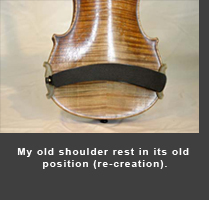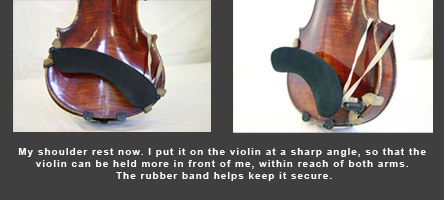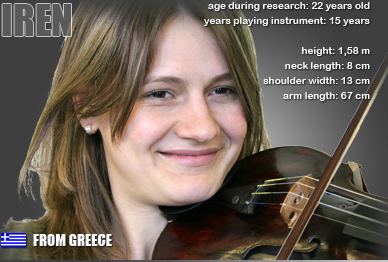3. Making the change
In the first Alexander Technique lesson we found out why I couldn't reach the tip of the bow: I was holding the violin very far to the left, over my left shoulder; the shoulder and chin rests didn't allow me to bring the violin within reach of the tip of the bow. Because I couldn't bring the violin forward to meet the bow, I had to lift the front of my body and throw my upper body backwards to try and reach the tip of the bow. Even my feet seemed to come off the floor.


Even during the first lesson we began to change the equipment, moving the chin rest from a position to the left of the tailpiece to one that fit over the tailpiece. This brought the fingerboard more in front of me. We had to ask the carpenter to decrease the height of the chin rest in order to fit it under my chin. Instead of a shoulder rest that was too big, we used a small square sponge covered in chamois leather.


Immediately I felt comfortable with my new equipment. On the other hand, everything started to feel more complicated. After playing more than ten years in the same old position, it was difficult to change everything in a moment. The first days I felt completely lost, as if the violin was something completely new for me! I spent more than two weeks thinking about it, observing my playing from all sides. It felt like starting to learn to play all over again.
When we first made the changes, the bow wasn't parallel with the bridge. The left hand was completely disorganized in relation to new position of the fingerboard. With the violin more in front of me, the sound suddenly came from a different place than before. This temporarily confused the balance of my head and was disorienting.
I had to deal with all these things at the same time. Looking for solutions, I found that turning off the lights in the practice room allowed me to use my hearing instead of my sight to orient me to the violin in its new position. It was only then that I discovered that before the changes the sound had come from the left into my left ear and the left back of my head, whereas now, I heard it in both ears from the front. This had given me quite a shock at first, which explained my initial disorientation. Now, with the lights out, it was almost like I could feel the "air" of the sound coming into my face. Finding out where the sound came from helped me to find my balance again and I stopped being confused.

Because I was using my sense of hearing better with the lights out, I not only could find where the violin was, but I was also forced to produce a nice sound. My musician's ear required me to find the new way to use the bow. Of course, this meant that the bow got straighter on the string, even in the dark.
In my Alexander Technique lessons we tried to find a good balance of my head and neck, which was very reassuring and helped me to work well with the new violin position. I also used the mirror to be sure that the bow was straight.
Using a sponge instead of my old shoulder rest allowed me to feel my own balance and the balance of the violin on my collar bone. However, the sponge was touching the back of the violin and I think that it was absorbing a lot of sound. This made listening more difficult, because the sound wasn't brilliant anymore. After I got used to the new position of the violin, it was possible to re-introduce a shoulder rest into my playing. I picked one with a smaller shape and I angled it differently on the violin, using a rubber band to make sure that it did not slip off.



